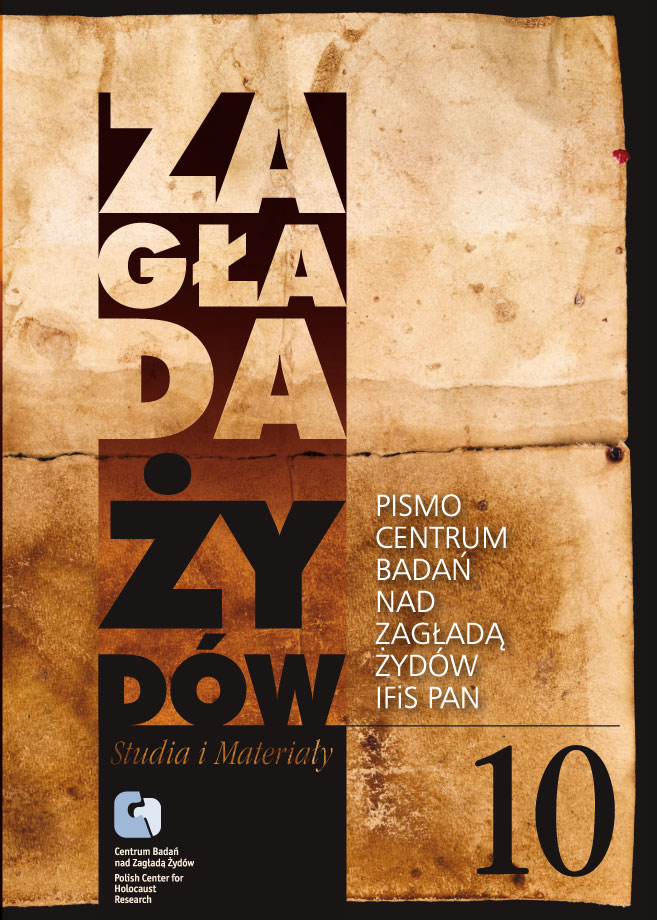W cieniu Anny Frank. Szanse Żydów na przeżycie w okupowanej Holandii
Zagłada Żydów. Studia i Materiały, Nr 10 (2014), Strony: 384-406
Data zgłoszenia: 2020-10-22Data publikacji: 2014-12-01
 https://doi.org/10.32927/ZZSiM.529
https://doi.org/10.32927/ZZSiM.529
Abstrakt
During the German occupation of the Netherlands between 1940 and 1945, around 75% of the country’s Jewish population were deported and killed, primarily in the extermination camps of Auschwitz and Sobibor. Much attention has been paid to the factors which explain this, but this article questions how any Jews managed to survive in an increasingly hostile environment where there were no ‘favorable factors’ to aid them. The analysis centers on the attitudes of the Jews towards acting illegally, their relationships with the rest of Dutch society, and the possible opportunities for escape and hiding. It also looks at the myriad problems associated with the day-to-day experiences of surviving underground
Słowa kluczowe
Żydzi w okupowanej Holandii , szanse przeżycia , ucieczki, siatki przerzutowe , ukrywanie się , kryjówki , samopomoc , pomoc z zewnątrz
Licencja
Prawa autorskie (c) 2014 Autor&"Zagłada Żydów. Studia i Materiały"

Utwór dostępny jest na licencji Creative Commons Uznanie autorstwa 4.0 Międzynarodowe.
https://creativecommons.org/licenses/by/4.0
Czasopismo publikowane jest w standardzie Diamond Open Access na licencji CC-BY-4.0 Deed - Uznanie autorstwa 4.0 Międzynarodowa - Creative Commons
Podobne artykuły
- Nechama Tec, Małgorzata Melchior, O pomocy, o ratowaniu Żydów i o badaniu Zagłady – z profesor Nechamą Tec rozmawia Małgorzata Melchior , Zagłada Żydów. Studia i Materiały: Nr 4 (2008)
- Jacek Leociak, Cenzor na straży Kościoła. Ocenzurowany pamiętnik Krystyny Modrzewskiej , Zagłada Żydów. Studia i Materiały: Nr 5 (2009)
- Jacek Leociak, Censorship Keeping Guard over the Church. Krystyna Modrzewska’s Censored Memoir , Zagłada Żydów. Studia i Materiały: 2010: Holocaust Studies and Materials
- Nawojka Cieślińska-Lobkowicz, Habent sua fata libelli. Okupacyjny rynek sztuki w Warszawie a własność żydowska , Zagłada Żydów. Studia i Materiały: Nr 10 (2014)
- Heléna Huhák, András Szécsényi, Kawalkada interpretacji. Pociąg Kastnera w osobistych narracjach uciekinierów , Zagłada Żydów. Studia i Materiały: Nr 18 (2022)
- Marcin Kula, W pierwszym kręgu. Listy ukrywającego się , Zagłada Żydów. Studia i Materiały: Nr 16 (2020)
- Jacek Leociak, Rocznice powstania w getcie warszawskim w dyskursie publicznym (ze szczególnym uwzględnieniem lat 1943–1944, 1968, 2023) , Zagłada Żydów. Studia i Materiały: Nr 19 (2023)
- Dariusz Libionka, Jan Grabowski, Anatomia donosu ks. Stanisława Trzeciaka na ks. Tadeusza Pudra , Zagłada Żydów. Studia i Materiały: Nr 13 (2017)
- Redakcja, Od Redakcji , Zagłada Żydów. Studia i Materiały: Nr 8 (2012)
- Krzysztof Czubaszek, Stanisław Żemis – świadek zagłady Żydów w Łukowie , Zagłada Żydów. Studia i Materiały: Nr 14 (2018)
1 2 3 4 5 6 7 8 9 10 11 12 13 14 15 16 17 18 19 20 21 22 23 24 25 26 27 28 29 30 31 32 33 34 35 36 37 38 39 40 41 42 43 44 45 46 47 48 49 50 > >>
Możesz również Rozpocznij zaawansowane wyszukiwanie podobieństw dla tego artykułu.
 English
English
 Język Polski
Język Polski



 https://orcid.org/0000-0001-6766-4264
https://orcid.org/0000-0001-6766-4264

